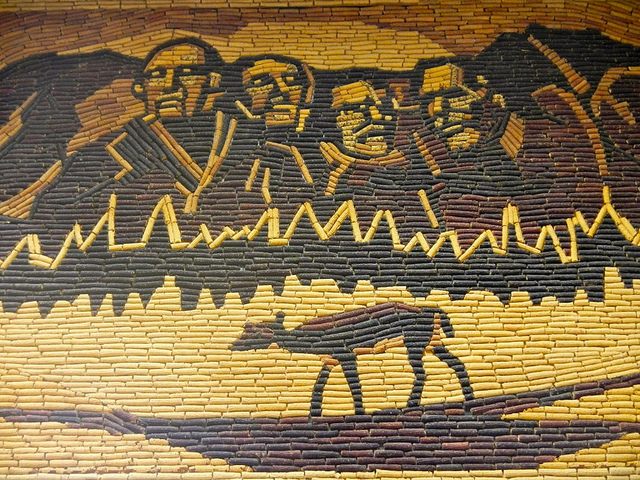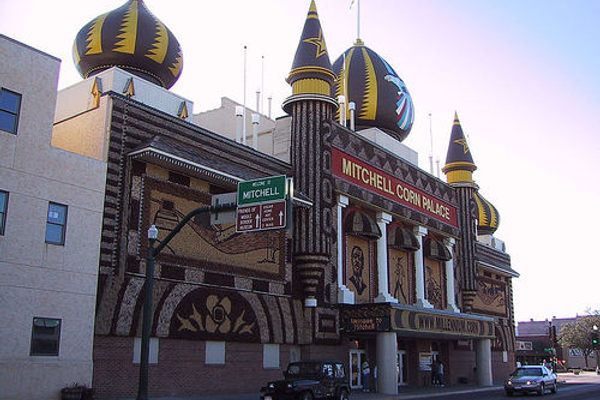Ear to the Ground: Intrigue at South Dakota’s Corn Palace

A corn mural from 2013 (Photo: PunkToad/Flickr)
In Mitchell, South Dakota, which is about 80 miles from the Minnesota border and 220 miles from Wall Drug, the Corn Palace is a very big deal. First built in 1892, this arena is decorated anew each year with elaborate murals made of corn and other grasses, grown locally—a testament to the agricultural prowess of eastern South Dakota.
The building, topped until recently with green and yellow onion domes, sits right on Main Street, next to City Hall. Every year, it draws a quarter of a million people into town from the interstate, feeding business to local gas stations and restaurants. At the end of every summer, there’s a Corn Palace Festival to celebrate its redecoration; the theme this year is South Dakota’s 125th. In the winter, the local high school basketball team, the Kernels, and the team from Dakota Wesleyan University (the less thematically named Tigers) host their home games inside.
In the past two years, though, as the city has invested millions of dollars in renovating and refurbishing the building, something strange has been brewing at the Corn Palace. For 13 years, from 2001 to 2014, the arena was run by the same director, Mark Schilling. But in 2014, he was asked to resign. Since then, the city has hired two directors, one of whom was asked to step down before even starting the job, and a second who lasted less than a year.

The renovated Corn Palace (Photo: Steven and Courtney Johnson/Flickr)
The Mitchell Daily Republic has been keeping close tabs on this palace intrigue, which began in 2013, when the Mitchell Police Division began looking into “allegations that Schilling had stolen popcorn owned by the Mitchell Area Chamber of Commerce and then sold it without permission,” reported Chris Mueller, who was covering the story for the Daily Republic at the time. (He has since left the paper.) Soon the investigation expanded, and the South Dakota Department of Legislative Audit began looking into the Corn Palace’s financial records.
While Schilling was the director, the audit found, there was a “lack of proper internal controls” to prevent against fraud and abuse in major revenue-generating parts of the operation, like the concession stand. As the investigation continued, it emerged that Schilling had used gift cards donated to the Corn Palace Festival to buy items for personal use, including a GoPro and a pistol. One city official also told investigators that she had bought unopened items from a garage sale run by Schilling’s sister-in-law and “matched them to vouchers the city received from a government program that provides certain items to municipalities,” Mueller reported. But when she had raised concerns, they had been brushed aside.
In March of 2014, Schilling resigned from the position he had held for over a decade; a year later, he was indicted and in May pled guilty to one count of petty theft.

A Corn Palace mural from 2005 (Photo: Scott Robinson/Flickr)
Since Schilling’s resignation, the city has had a difficult time finding a replacement. Former Mayor Ken Tracy offered the job to Steven Koch but then announced that Koch had withdrawn his name from consideration. Koch had previously been charged with and pled guilty to one count of petty theft, but as Evan Hendershot reported for the Daily Republic, “Tracy was aware of Koch’s criminal record…but offered him the position anyway.” Koch is now suing the city and the former mayor for breach of contract and other wrongs. In December 2014, Mayor Tracy settled on another candidate, Dan Sabers as director. Sabers held the position until September of this year.
“Friends of his claim he was forced out, but we don’t have any hard proof on that,” says Hendershot, who’s been covering the story since he started working at the Republic earlier this year. The City Council also handled the situation badly; the paper ended up filing a open meetings complaint about a closed executive session in which the resignation was discussed out of view of the public.
While all this was going on, the Corn Palace was in the middle of one of the largest renovations in its history. The city was spending $4.7 million on the first phase of the project, which includes new floors, signs, box office, balcony, and, most dramatically, new domes on top. Although the project has remained on budget, there were many delays in construction, and some people blamed Mayor Tracy for that, Hendershot says. In the 2015 mayoral election, over the summer, he lost to his challenger, Jerry Toomey, who was sworn into office this July.

The Corn Palace, before the renovation (Photo: designatednaphour/Flickr)
Mitchell is a fairly small place, a city of 15,000 or so people. Besides the Corn Palace renovation and turnover, the main issues that Hendershot has been covering are a multi-million dollars project to mitigate algae and agriculture run-off in a local, man-made lake and turnover in the city government in the wake of the new mayor’s election.
The Corn Palace was originally intended as an advertisement for the agricultural richness of the area, and built by a local real estate association, says Jan Cerney, author of Mitchell’s Corn Palace. “It was a showcase to display and promote the agriculture area,” she says. “Over the years, it hasn’t been quite as important at the beginning.”
Those 250,000 tourists help the economy, of course, but there’s also Dakota Wesleyan and a technical college in town, as well as some manufacturing. South of the interstate, there’s a shopping area, with WalMart, Cabela’s (the source of the gift cards that Schilling stole), and other chain stores.

Another South Dakota wonder (Photo: PunkToad/Flickr)
“We have a very low unemployment rate,” says Katie Knutson, of the Mitchell Area Chamber of Commerce. “There are a lot of open positions in our community that aren’t being filled.”
Including, for the moment, the Corn Palace director position. Applications closed early in October, and the city is looking through dozens of candidates who applied. “From the mayor’s perspective, I think he’s happy about the direction it’s going,” says Hendershot.














Follow us on Twitter to get the latest on the world's hidden wonders.
Like us on Facebook to get the latest on the world's hidden wonders.
Follow us on Twitter Like us on Facebook